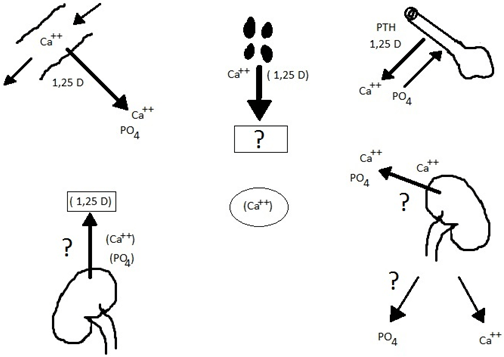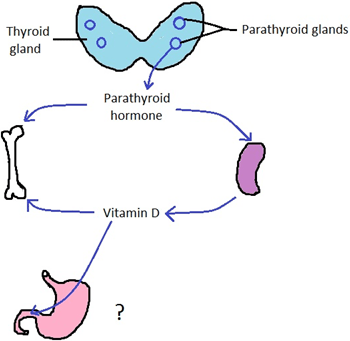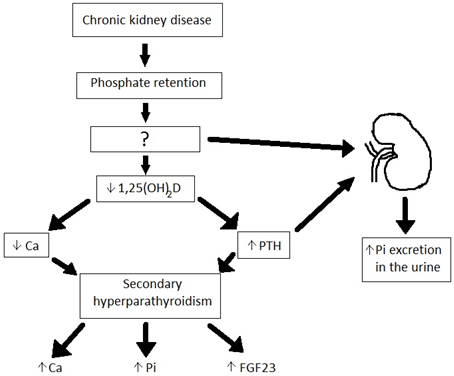This set of Molecular Endocrinology Multiple Choice Questions & Answers (MCQs) focuses on “Mineral Metabolism – Calcium and Phosphate Homeostasis”.
1. Given below is the diagram showing the adaptations to dietary calcium deprivations. So here, which among the following hormones is secreted to take part in the adaptation mechanism?

a) PTH
b) FSH
c) TSH
d) LH
View Answer
Explanation: Dietary restriction of calcium leads to an increase in the efficiency of the absorption of intestinal calcium. This increased efficiency results from a sequence of homeostatic responses in which PTH secretion is activated by the reduced concentration of ionized calcium in the blood.
2. Which mineral metabolism and homeostasis is depicted in the diagram given below?

a) Phosphorus
b) Calcium
c) Potassium
d) Sodium
View Answer
Explanation: The process by which our body maintains required calcium levels is known as calcium metabolism or calcium homeostasis. Mainly, there are three calcium regulating hormones functioning in our body. They include, calcitonin, parathyroid hormone and calcitriol, among which calcitonin reduces the blood calcium levels, where as PTH and calcitriol increases the same.
3. Given below is the diagram showing phosphate homeostasis in chronic kidney disease. Here, which is the main hormone that take part in maintaining phosphate homeostasis?

a) PTH
b) Calcitonin
c) FGF23
d) Epinephrine
View Answer
Explanation: In murine models of overexpression and ablation, evidence that FGF23 is a novel hormone that plays a key role in normal phosphate homeostasis has been obtained. The occurrence of hypophosphatemia and impaired 1 alpha-hydroxylation of 25(OH)D results in over-expression of FGF23 or administration of FGF23 to animals.
4. Quantitatively, the most important response to calcium deficiency is enhanced intestinal calcium absorption.
a) True
b) False
View Answer
Explanation: PTH created by low levels of calcium increases calcitriol synthesis and calcitriol then acts directly on enterocytes to increase calcium active transcellular transport. The most important response to calcium deficiency is quantitatively increased intestinal calcium absorption, but a variety of other homeostatic events also occur that limit the impact of this stress.
5. Calcitriol also improves intestinal phosphate absorption.
a) True
b) False
View Answer
Explanation: Calcitriol also improves intestinal phosphate absorption. These loads of phosphate are problematic in that phosphate directly reduces ionized calcium in ECF, suppresses calcitriol renal synthesis, and inhibits bone resorption directly. The powerful phosphaturic actions of PTH and FGF23 obviate these potentially negative phosphate effects.
6. Expression of which among the following proteins, increases the renal tubular calcium reabsorption by PTH?
a) CREB protein
b) Calbindin-D28K
c) Calcinone-1123K
d) Alloxzine-09K
View Answer
Explanation: Renal tubular calcium reabsorption is increased by PTH, an effect enhanced in the distal tubules by increased calcitriol-stimulated calbindin-D28K expression. Calcium reabsorption is also specifically enhanced by any hypocalcemia tendency that is observed in Henle’s loop by CASRs.
7. Along with PTH and FGF23, which other hormone is involved in the regulation of calcium and phosphate homeostasis?
a) Calcitriol
b) Cholecalciferol
c) Aromatases
d) TSH
View Answer
Explanation: Mineral ion levels are regulated by PTH, calcitriol, and FGF23, which in turn regulate PTH, calcitriol, and FGF23 secretion, and these hormones can regulate one another’s development. Calcium sensors in the parathyroid glands regulate PTH secretion by controlling ionized calcium levels, while calcium sensors in the kidney regulate tubular calcium reabsorption without regard to PTH or calcitriol.
8. Parathyroid disease is usually a late and infrequent (5% to 20%) occurrence in patients with which among the following diseases
a) Hyperparathyroidism–Jaw Tumor Syndrome
b) Multiple Endocrine Neoplasia Type 1
c) Hyperparathyroidism
d) Multiple Endocrine Neoplasia Type 2a
View Answer
Explanation: Parathyroid disease typically occurs late and rarely (5 to20%) in patients with type 2a MEN, a disease characterized by the clustering of thyroid medullary carcinoma, pheochromocytoma, and hyperparathyroidism. Hyperparathyroidism is more prevalent in some families, but these families have the same mutations without hyperparathyroidism in the RET proto-oncogene.
9. Which among the following disease is caused by inactivating mutations in the tumor suppressor gene encoding menin?
a) Hyperparathyroidism–Jaw Tumor Syndrome
b) Multiple Endocrine Neoplasia Type 1
c) Hyperparathyroidism
d) Multiple Endocrine Neoplasia Type 2a
View Answer
Explanation: MEN1 is caused by inactivating mutations that encode menin in the tumor suppressor gene. Menin is a transcription factor widely expressed, that is part of a complex which targets methylation of histone H3 and thus contributes to the development of cell cycle inhibitors in pancreatic islets and other tissues.
10. Mutations in genes encoding which cyclin-dependent kinase inhibitor is found in MEN1 patients without menin mutations?
a) p23 (CD9)
b) p27 (CDKN1B)
c) P53 (LOPERIN)
d) p53 (CDKN1B)
View Answer
Explanation: Mutations in genes encoding cyclin-dependent kinase inhibitors such as p27 (CDKN1B) are rarely observed in non-menin mutated MEN1 patients. While MEN1 involves parathyroid, anterior pituitary, and pancreatic islet tumors, the parathyroid tumors are far more prevalent than the others; hyperparathyroidism eventually develops in 95 percent of affected patients.
Sanfoundry Global Education & Learning Series – Molecular Endocrinology.
To practice all areas of Molecular Endocrinology, here is complete set of 1000+ Multiple Choice Questions and Answers.
If you find a mistake in question / option / answer, kindly take a screenshot and email to [email protected]
